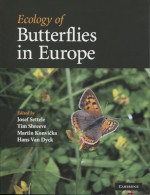Ecology of Butterflies in Europe
- ISBN: 9780521747592
- Editorial: Cambridge University Press
- Fecha de la edición: 2009
- Lugar de la edición: Cambridge. Reino Unido
- Encuadernación: Rústica
- Medidas: 25 cm
- Nº Pág.: 526
- Idiomas: Inglés

Due to the attractiveness of butterflies, and their usefulness as model systems for biological questions, there has been a considerable amount of material written on butterfly biology, largely in Europe. This book synthesizes all relevant and recent knowledge in the field, which is a must for those making use of this taxonomic group as a model system. It is divided into five major parts which deal with habitat use, population ecology and genetics, evolutionary ecology, distribution and phylogeny, and global change and conservation. There are growing numbers of scientific projects and networks in Europe in which the use of butterflies as tools and targets for conservation is central, and application of knowledge is closely related to European cultural landscapes. However, the chapters can also be applied to a wide geographic scope. Written by an international team of experts, this timely book is suitable for students, researchers and enthusiasts.
Compiles highly relevant information that is currently 'hidden' in many regional publications
Is clearly structured into five major parts, allowing the reader to categorise different aspects of biology
Reviews major topics of contemporary biology, giving specific examples of butterfly ecology.
Preface
1. Introduction: ecology of butterflies in Europe – where are we now and where to go? Roger Dennis
Part I. Habitat-Use: Resources and Constraints:
2. Adult food resources in butterflies Andreas Erhardt and Jovanne Mevi-Schütz
3. Mating behaviour in butterflies Per-Olof Wickman
4. Butterfly oviposition: sites, behaviour and modes Enrique García-Barros and Thomas Fartmann
5. Butterfly herbivory and larval ecology Miguel L. Munguira, Enrique Garcia-Barros and José Martin Cano
6. Thermoregulation and habitat use in butterflies Per-Olof Wickman
7. Predictive species distribution modelling in butterflies Boris Schröder, Barbara Strauss, Birgit Binzenhöfer, Robert Biedermann and Josef Settele
Part II. Population Biology: Population Structure, Dynamics and Genetics:
8. Butterfly population structure and dynamics Rob Wilson and David Roy
9. Costs and benefits of dispersal in butterflies Thomas Hovestadt and Marko Nieminen
10. Population genetics of butterflies Gabriel Nève
11. Parasitoids of European butterflies Mark Shaw, Constanti Stefanescu and Saskya van Nouhuys
Part III. Evolutionary Ecology:
12. Adaptation and plasticity in butterflies: the interplay of genes and environment Hans Van Dyck and Jack Windig
13. Functional significance of butterfly wing morphology Tim Shreeve, Martin Konvicka and Hans Van Dyck
14. Evolutionary ecology of butterfly fecundity Bengt Karlsson and Hans Van Dyck
15. Gradients in butterfly biology Sören Nylin
Part IV. Species in Time and Space: Distribution and Phylogeny:
16. Bad species - how ecology and evolution confuse butterfly taxonomy Henri Descimon and James Mallet
17. Butterfly faunal structures, phylogeography, and historical implications Roger Dennis and Thomas Schmitt
18. Butterfly richness patterns and gradients David Gutierrez
19. Ecological genetics and evolutionary ecology in butterfly hybrid zones Adam Porter
Part V. Global Change and Conservation:
20. Climate warming and distribution changes in butterflies Jane K. Hill, Ralf Ohlemüller, Richard Fox and Chris D. Thomas
21. Conservation status of European butterflies Chris Van Swaay, Dirk Maes and Martin Warren
22. (Meta)population viability analysis in butterflies: a crystal ball for the conservation of endangered butterflies? Nicolas Schtickzelle and Michel Baguette
23. Butterflies of European ecosystems: impact of land use and options for conservation management Josef Settele, John Dover, Matthias Dolek and Martin Konvicka.






